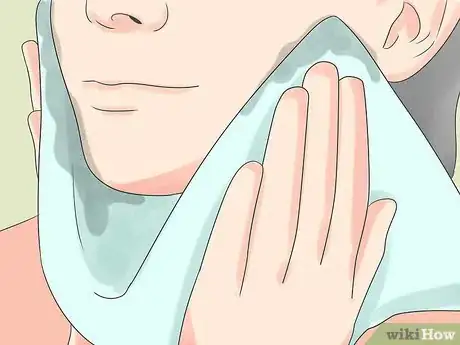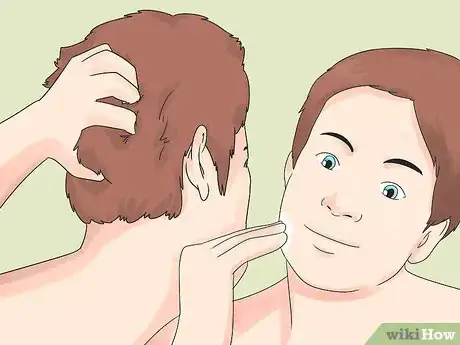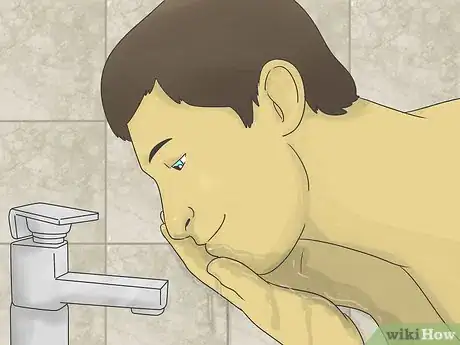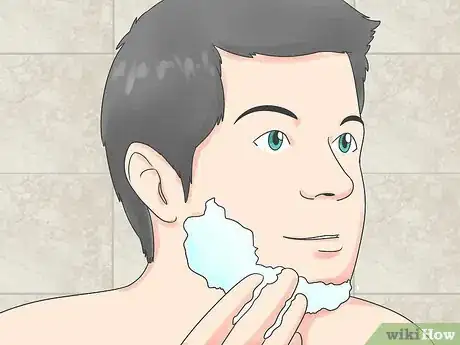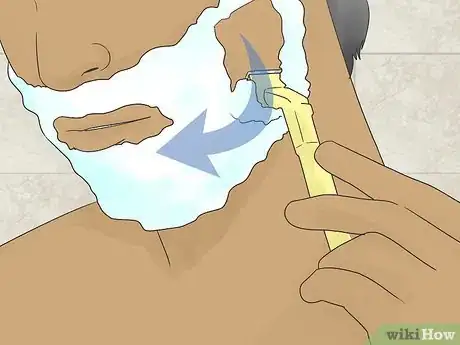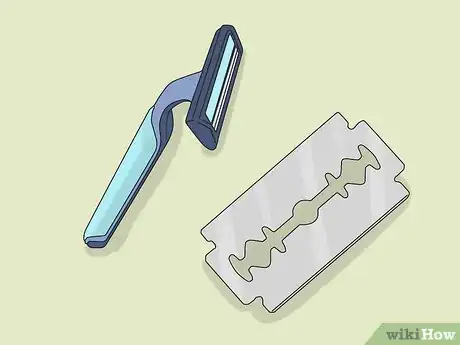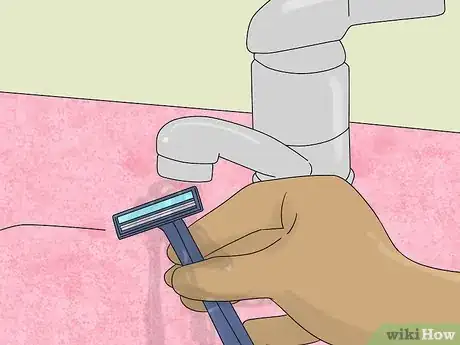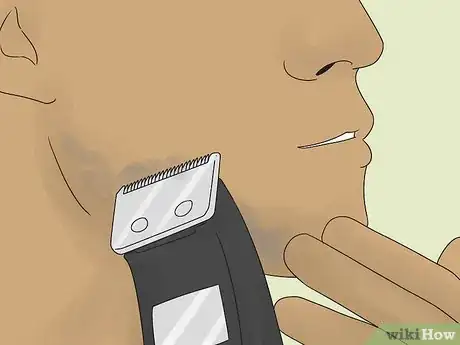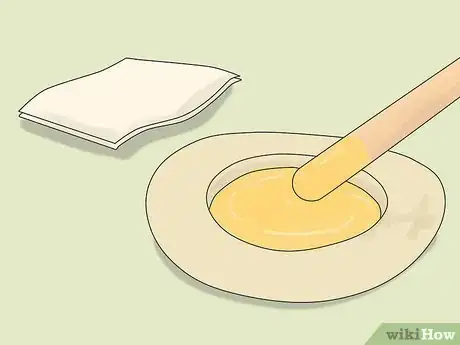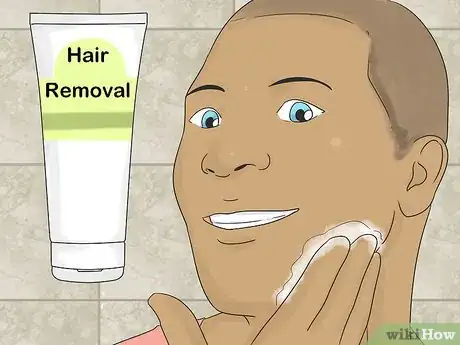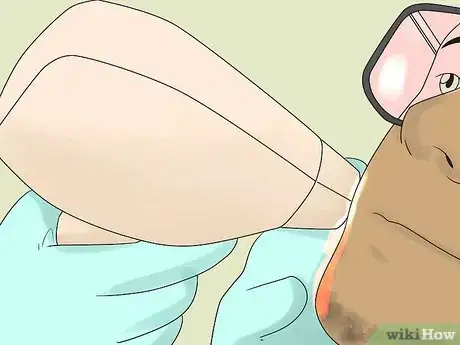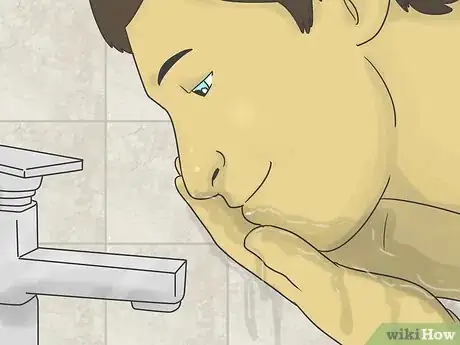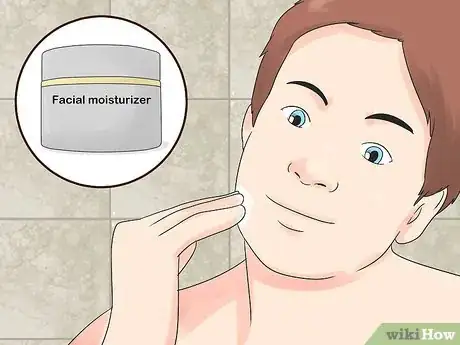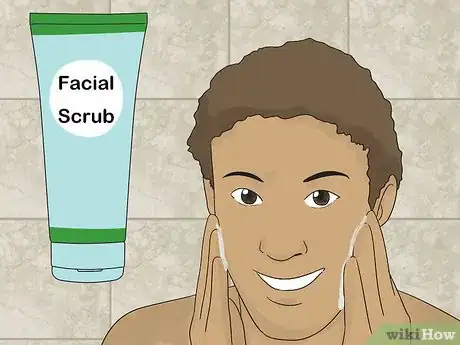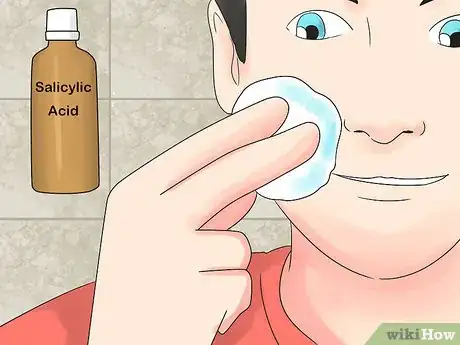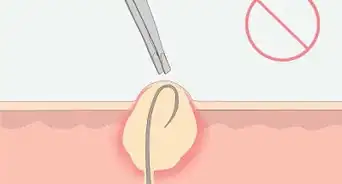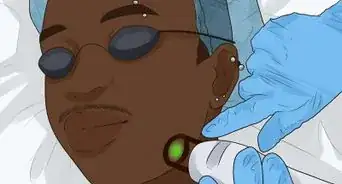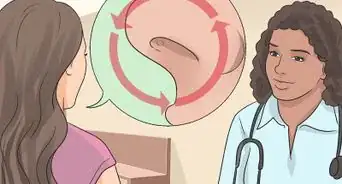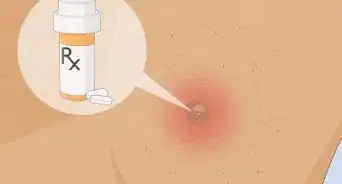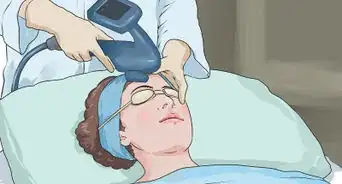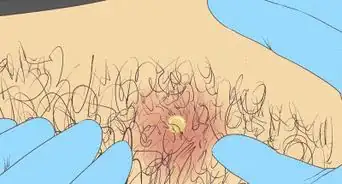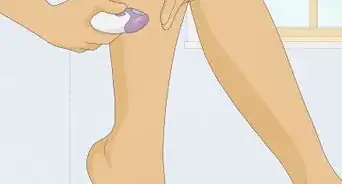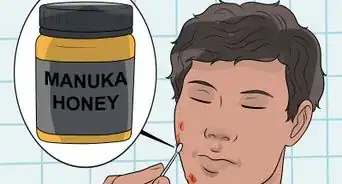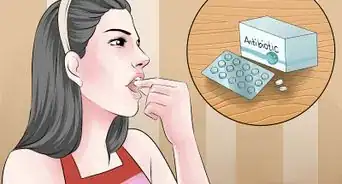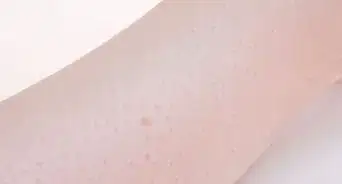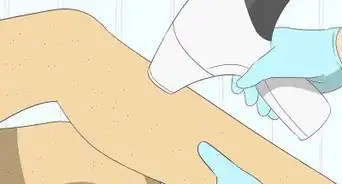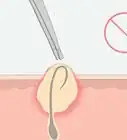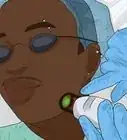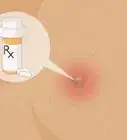This article was medically reviewed by Sarah Gehrke, RN, MS and by wikiHow staff writer, Megaera Lorenz, PhD. Sarah Gehrke is a Registered Nurse and Licensed Massage Therapist in Texas. Sarah has over 10 years of experience teaching and practicing phlebotomy and intravenous (IV) therapy using physical, psychological, and emotional support. She received her Massage Therapist License from the Amarillo Massage Therapy Institute in 2008 and a M.S. in Nursing from the University of Phoenix in 2013.
There are 15 references cited in this article, which can be found at the bottom of the page.
This article has been viewed 582,220 times.
Ingrown hairs happen when a shaved or plucked hair begins to grow back in under the skin instead of emerging from the follicle. This process not only causes unsightly red bumps, but can also lead to irritation, infection, or even permanent scarring. Reduce your chances of getting ingrown hairs by properly preparing your skin before hair removal and using safe, gentle hair-removal techniques. Once you’ve removed the hair, use appropriate aftercare to make ingrown hairs even less likely.
Steps
Preparing Your Skin and Hair
-
1Exfoliate your skin regularly. Exfoliating can remove dead skin cells that build up on the skin and clog your hair follicles.[1] Gently exfoliate the areas where you plan to remove hair by gently rubbing your skin with a wet washcloth or a mild exfoliating scrub.
- Use circular motions while exfoliating for maximum effectiveness.
- You can make a gentle exfoliating scrub at home by mixing three parts baking soda with one part water.[2] Use this scrub once a week for best results.
- Chemical exfoliants, like alpha hydroxy acids, are also effective.[3]
-
2Moisturize your skin and hair. Keeping your skin and hair hydrated will make your skin less prone to over drying and your hair less prone to breakage. Soft, hydrated hair is also easier to shave. After exfoliating your skin, treat it with a gentle moisturizing lotion.[4]
- Check the label on your moisturizer to make sure that it is non-comedogenic (won't clog your pores).
- If you plan to shave your head hair, you can keep it moisturized and supple with a hair conditioner.
- You can help keep your body and facial hair moisturized just before or during a shave by soaking the hair in warm water and using a lubricating gel or moisturizing shaving cream.
Advertisement -
3Clean your skin before removing hair. Most hair removal techniques leave your skin and follicles more vulnerable to infection. Use warm water and a mild face or body cleanser to wash away dirt and bacteria before shaving, plucking, or waxing.[5]
Using Good Shaving Techniques
-
1Wet your skin and apply gel or shaving cream before shaving. If shaving is your preferred method of hair removal, keeping your hair and skin moisturized during the shave is a must. Using a cream or gel will make the hair easier to cut, and will prevent skin irritation.
- For best results, apply your shaving gel or cream a few minutes before you start shaving.[6]
- It’s a good idea to shave in the shower or immediately after getting out of the shower. The warm water will soften the hair, making shaving much easier.
-
2Shave in the direction of hair growth. Shaving “with the grain” may help reduce friction and prevent damage and irritation to your skin. However, this technique doesn’t work for everyone. Experiment with the shaving direction that is most effective and least irritating for you.[7]
- Also, make sure that you do not pull your skin taut while you are shaving it. This may lead to ingrown hairs.[8]
-
3Shave with a sharp blade. A sharp blade will cut your hair more easily and is less likely to irritate your skin. If your razor is getting dull, replace it with a new one.[9]
- While some experts recommend using a single blade razor, it is unclear whether this really helps prevent the development of ingrown hairs. Stick with your multi-blade razor if you find that it is less irritating and more effective for you.[10]
-
4Rinse your razor frequently while shaving. Razors quickly become clogged with shaving gel and hair during the shaving process, which reduces their effectiveness and makes irritation more likely. Rinse your razor between strokes to prevent buildup and keep it shaving smoothly.[11]
-
5Shave with an electric razor. Electric razors and clippers don’t cut as close to the skin as traditional safety razors, which can reduce your chance of developing ingrown hairs. It may be worthwhile to sacrifice a super close shave if you shave frequently and regularly develop ingrown hairs.[12]
- Avoid setting your razor/clippers on the closest shave setting, and hold the blade slightly away from your skin while shaving.
- Do not use your electric razor unless it is fully charged. If the razor battery is low, then the blades may pull at your hairs, which can be painful.
Using Other Hair Removal Techniques
-
1Use sanitary waxing practices. If you decide to wax instead of shave, you are still at risk for getting ingrown hairs, especially in the bikini area. Always cleanse and exfoliate your skin before waxing. Reduce your risk of infection by using a new applicator stick for each application of wax.[13]
-
2Try a chemical hair remover. Depilatory creams work by dissolving the hair rather than cutting it or pulling it out of the skin. For this reason, they are less likely to lead to ingrown hairs.[14]
- Chemical hair removers can cause rashes or irritation in some people. Test the product on a small area of your skin before use.[15]
-
3Use laser hair removal.[16] Laser hair removal is a semi-permanent hair removal technique that involves destroying the hair and the root with a guided laser beam. While this technique does not usually completely eliminate hair in the treated area, it will reduce hair density significantly. This reduces the need for shaving, plucking, and other hair removal techniques that lead to ingrown hairs.[17]
- Laser hair removal is relatively safe, and the side effects (typically redness and irritation) are usually mild and temporary. In rare cases, permanent scarring may occur.
- Keep in mind that laser hair removal can be costly. Typically, multiple treatments are needed over the course of several months for the treatment to be effective.
Treating Your Skin after Hair Removal
-
1Rinse your skin with cool water after shaving. Splash on a little cold water, or gently wipe the shaved area with a cold, wet washcloth. Rinsing will help cleanse the skin, close up your pores, and reduce irritation.[18]
-
2Apply a moisturizing lotion after removing hair. Whether you wax, pluck, or shave, it’s a good idea to treat your skin with a gentle lotion afterwards. Make sure your lotion is free of perfumes and alcohol.[19] Moisturizers containing colloidal oatmeal or aloe may be particularly soothing.[20]
- You may also try applying some cool chamomile tea to your skin after shaving. Chamomile is soothing and it has antibacterial properties.[21]
-
3Exfoliate again after removing hair. Exfoliating is especially important after waxing, since it can help new hair growth emerge the way it’s supposed to. Apply a mild, gentle exfoliating scrub daily for the first few days after waxing.[22]
-
4Use glycolic acid or salicylic acid on your skin. Glycolic and salicylic acid both help exfoliate the skin and prevent ingrown hairs by keeping pores unclogged. Salicylic acid is a key ingredient in many acne medications, so it can also help prevent post-shave breakouts.[23]
- Try post-shave serum or cleansing pads containing glycolic and/or salicylic acid. If your skin is sensitive, you may need to avoid using these products more than once a week.
- Avoid using glycolic or salicylic acid on freshly shaved or waxed skin. Let your skin rest and heal for a day or two before applying.
- These products can be drying, so use them in combination with a moisturizer.
Expert Q&A
-
QuestionHow do you treat an ingrown hair scar?
 Heather Richmond, MDDr. Heather Richmond, MD is a board certified Dermatologist at Dermatology and Laser Surgery Center in Houston, Texas. With over nine years of experience, Dr. Richmond specializes in comprehensive dermatology including medical, surgical, and cosmetic procedures. She graduated cum laude from Yale University with a BA in Molecular, Cellular, and Developmental Biology. She earned her MD from the University of California, Irvine School of Medicine, where she was inducted into the Alpha Omega Alpha Honor Medical Society. She completed her Internal Medicine internship at Cedars-Sinai Medical Center and her Dermatology residency at The University of Texas MD Anderson Cancer Center in Houston. Dr. Richmond is a fellow of the American Academy of Dermatology and is a member of the American Society for Dermatologic Surgery, American Society for Laser Medicine and Surgery, and the Texas and Houston Dermatological Societies.
Heather Richmond, MDDr. Heather Richmond, MD is a board certified Dermatologist at Dermatology and Laser Surgery Center in Houston, Texas. With over nine years of experience, Dr. Richmond specializes in comprehensive dermatology including medical, surgical, and cosmetic procedures. She graduated cum laude from Yale University with a BA in Molecular, Cellular, and Developmental Biology. She earned her MD from the University of California, Irvine School of Medicine, where she was inducted into the Alpha Omega Alpha Honor Medical Society. She completed her Internal Medicine internship at Cedars-Sinai Medical Center and her Dermatology residency at The University of Texas MD Anderson Cancer Center in Houston. Dr. Richmond is a fellow of the American Academy of Dermatology and is a member of the American Society for Dermatologic Surgery, American Society for Laser Medicine and Surgery, and the Texas and Houston Dermatological Societies.
Board Certified Dermatologist If the scar is just discoloration, using a bleaching cream can be helpful. For thickened scars, injectable steroids can be quite beneficial as well.
If the scar is just discoloration, using a bleaching cream can be helpful. For thickened scars, injectable steroids can be quite beneficial as well.
Warnings
- If you do get an ingrown hair, don’t attempt to remove it by picking at the skin. If the problem does not resolve on its own, your doctor may be able to release the hair by making a small incision in your skin. They may also recommend a topical treatment to reduce inflammation and help the hair emerge.⧼thumbs_response⧽
References
- ↑ http://nyulangone.org/press-releases/nyu-langone-skin-expert-offers-practical-advice-and-best-practices-for-dealing-with-ingrown-hair-or-razor-bumps
- ↑ http://www.today.com/style/surprising-beauty-uses-baking-soda-I513725
- ↑ Heather Richmond, MD. Board Certified Dermatologist. Expert Interview. 15 September 2020.
- ↑ http://www.totalbeauty.com/content/gallery/p-at-home-waxing/p32792/page2
- ↑ http://www.mayoclinic.org/diseases-conditions/ingrown-hair/basics/prevention/con-20034717
- ↑ http://www.mayoclinic.org/diseases-conditions/ingrown-hair/basics/prevention/con-20034717
- ↑ http://www.mayoclinic.org/diseases-conditions/ingrown-hair/basics/prevention/con-20034717
- ↑ http://www.mayoclinic.org/diseases-conditions/ingrown-hair/basics/definition/CON-20034717?p=1
- ↑ http://www.cosmopolitan.com/uk/beauty-hair/a9166539/how-to-stop-ingrown-hairs/
- ↑ http://www.mayoclinic.org/diseases-conditions/ingrown-hair/basics/prevention/con-20034717
- ↑ http://www.mayoclinic.org/diseases-conditions/ingrown-hair/basics/prevention/con-20034717
- ↑ http://www.mayoclinic.com/health/ingrown-hair/DS01167/DSECTION=prevention
- ↑ http://www.onemedical.com/blog/live-well/hair-removal-methods/
- ↑ https://www.healthdirect.gov.au/ingrown-hair
- ↑ http://www.mayoclinic.org/diseases-conditions/ingrown-hair/basics/prevention/con-20034717
- ↑ Heather Richmond, MD. Board Certified Dermatologist. Expert Interview. 15 September 2020.
- ↑ https://www.healthdirect.gov.au/ingrown-hair
- ↑ http://www.today.com/style/how-get-perfect-shave-2D80554959
- ↑ http://www.shape.com/lifestyle/beauty-style/6-tricks-how-shave-your-bikini-area
- ↑ https://www.ncbi.nlm.nih.gov/pubmed/17373175
- ↑ https://www.ncbi.nlm.nih.gov/pubmed/25632475
- ↑ http://www.allure.com/story/how-to-prevent-ingrowns-after-bikini-wax
- ↑ http://nyulangone.org/press-releases/nyu-langone-skin-expert-offers-practical-advice-and-best-practices-for-dealing-with-ingrown-hair-or-razor-bumps
About This Article
To prevent ingrown hairs, exfoliate your skin regularly to remove dead skin cells that may clog up your hair follicles. After you exfoliate, apply a moisturizing lotion to your skin to stop it from drying out. When you shave, apply a foam or gel first to make the hair easier to cut. Also use an electric razor, which doesn't shave so closely and is less likely to cause ingrown hairs. If you wax instead, remember to clean and exfoliate your skin before waxing to guard against ingrown hairs. For tips on how to use chemical hair removers and how to treat your skin after hair removal, read on!
